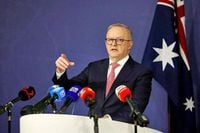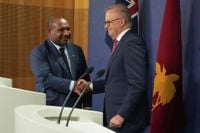On the eve of Papua New Guinea’s golden jubilee of independence, a historic agreement is set to reshape the security landscape of the South Pacific. Australian Prime Minister Anthony Albanese and his Papua New Guinean counterpart, James Marape, will sign a groundbreaking defense pact on September 17, 2025, in Port Moresby, marking a new era of military integration and cooperation between the two neighbors. The timing is no coincidence: the ceremony comes just one day after Papua New Guinea (PNG) celebrates its 50th anniversary of independence from Australia, underscoring the enduring ties—and evolving dynamics—between the two countries.
Prime Minister Albanese, speaking to Australian Broadcasting Corp. before departing Perth, described the pact as “a very significant upgrade in our defense relationship.” He elaborated, “It provides for mutual defense, which means that we will provide support for each other, provide for an integration of our interoperability of our assets and our respective defense forces.” Albanese’s remarks reflect the sense of urgency and strategic calculation underpinning the agreement, as Australia seeks to counter China’s growing influence in the Pacific region.
The new treaty, which replaces a 1977 agreement made with a newly independent PNG, will see the two countries “totally integrate” their defense forces. This goes far beyond mere interoperability—Papua New Guinea’s defense minister Billy Joseph told ABC, “We’re not talking about interoperability, we’re talking about totally integrated forces.” The deal allows citizens from both nations to serve in each other’s militaries, a first for Australia outside its traditional Five Eyes intelligence-sharing partners (the US, UK, Canada, and New Zealand). As a further incentive, Australia will offer citizenship to Papua New Guineans who enlist in its military, a move expected to strengthen people-to-people ties and build trust between the two countries’ armed forces.
With a population nearing 12 million, PNG is the most populous South Pacific nation after Australia, which has around 27 million people. The integration of their defense forces is not just symbolic—it’s a practical response to shifting regional dynamics. Since 2019, three Pacific island nations have switched diplomatic recognition from Taiwan to Beijing, signaling China’s increasing sway in the region. According to The Independent, the latest show of force came just last week, when China sailed its newest aircraft carrier through the Taiwan Strait. In response, Australia sent the destroyer Brisbane through the same waters, drawing Beijing’s ire.
The US and its allies, including Australia, are particularly concerned by China’s expanding security presence, which includes police training and cooperation programs in Fiji, Kiribati, Samoa, Solomon Islands, and Vanuatu. These developments have heightened anxieties in Canberra and Washington about the balance of power in the Pacific. The presence of US Deputy Secretary of State Christopher Landau at the signing in Port Moresby is a clear signal of Washington’s support for the pact and its broader regional implications.
But the path to this agreement hasn’t been smooth. In May 2023, protests erupted in PNG over a separate security deal with the United States, delaying the Australia-PNG pact by six months. Many Papua New Guineans feared the US agreement would undermine their national sovereignty. This sensitivity to sovereignty is a recurring theme in Pacific diplomacy. As Oliver Nobetau, project director of the Australia–Papua New Guinea Network at the Lowy Institute, told ABC, “If there’s any wording around Australia being the security partner of choice for a country like Papua New Guinea, that would be a big win” for Australia. But, he added, “We know that Pacific countries, PNG in particular, have been quite adamant about protecting their sovereignty, which means removing the sort of language that excludes third-party partnerships.”
This balancing act—strengthening alliances without alienating other partners or appearing to take sides in the escalating competition between the US and China—has become the defining feature of Pacific diplomacy. Several island nations have been careful not to align too closely with either bloc, preferring to keep their options open. In fact, Albanese’s recent attempt to sign a similar security and economic treaty with Vanuatu stalled over concerns about how such a deal might affect Vanuatu’s ability to secure infrastructure funding from China.
Australian Defense Minister Richard Marles called the new bilateral treaty with PNG “transformational.” He emphasized that it upgrades the relationship to a level comparable with Australia’s alliance with the United States. “This is a transformational agreement between ourselves and PNG,” Marles said, highlighting the significance of the pact for both nations’ security and regional stability. Marles also indicated that Australia would continue discussions with Fiji and Tonga to advance bilateral defense cooperation, suggesting that Canberra is keen to extend its influence and partnerships across the Pacific.
The integration of the two militaries will also mean more joint training, shared use of military assets, and coordinated responses to regional threats—from natural disasters to external aggression. For PNG, the agreement offers not just enhanced security but also opportunities for professional development and international exposure for its soldiers. For Australia, it cements its role as the preferred security partner in the Pacific, at a time when that status can no longer be taken for granted.
The symbolism of the timing is hard to miss. As PNG marks 50 years of independence, the nation is asserting its sovereignty and agency, even as it draws closer to its former colonial ruler. Albanese put it succinctly: “It means that Papua New Guinea is choosing … its own interest, going forward, and its sovereignty.” The deal is as much about mutual respect and partnership as it is about hard security.
Looking ahead, the success of this new defense pact will depend on how well both countries manage the delicate balance between deepening their alliance and respecting PNG’s desire for autonomy and flexibility in its international relationships. The wording of the agreement—particularly any reference to exclusivity—will be scrutinized closely by regional observers and by Beijing, which is unlikely to view the development with indifference.
As the ink dries on this historic agreement, the eyes of the Pacific—and indeed, the world—will be watching. The Australia-Papua New Guinea defense pact is more than just a bilateral deal; it’s a barometer of shifting power dynamics and a test of whether old allies can adapt to new realities in a rapidly changing region.
With regional tensions simmering and strategic competition intensifying, the coming years will show whether this “transformational” partnership delivers on its promise of shared security and mutual respect—or simply adds another layer of complexity to the Pacific’s intricate geopolitical tapestry.





